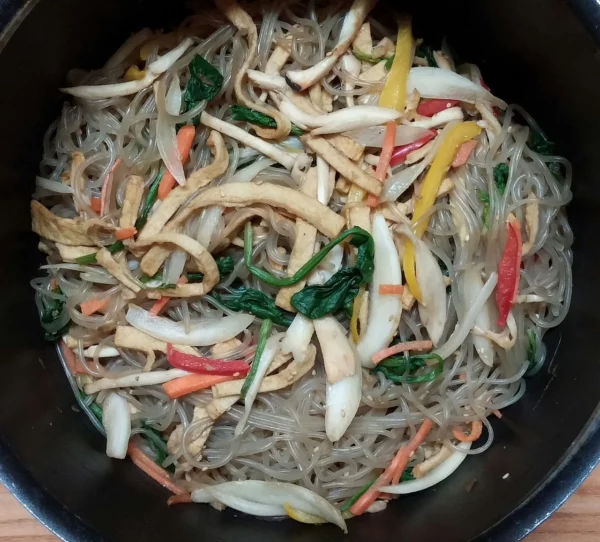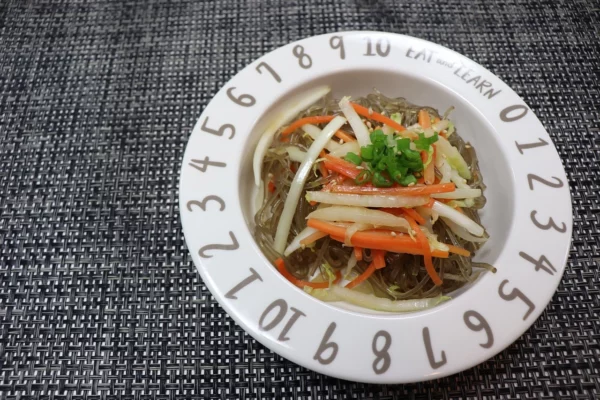Master the art of making Japchae, Korea’s beloved sweet potato noodles. Follow our simple recipe for perfect results!

Mastering Sweet Potato Glass Noodles: A Comprehensive Guide
Sweet potato glass noodles, also known as dangmyeon, are a staple in many Asian cuisines, particularly Korean. These noodles are not only delicious but also offer a unique texture and versatility that make them perfect for a variety of dishes. In this guide, we will delve into the intricacies of cooking sweet potato glass noodles to perfection, ensuring you can create delectable meals that will impress any palate.
Understanding Sweet Potato Glass Noodles
Sweet potato glass noodles are made from sweet potato starch and water. They are known for their translucent appearance and chewy texture when cooked. These noodles are naturally gluten-free, making them a great alternative for those with gluten sensitivities.
Key Characteristics
- Translucency: The noodles turn translucent upon cooking.
- Chewiness: Offers a distinct, slightly chewy texture.
- Neutral Flavor: Absorbs the flavors of the sauces and ingredients they are cooked with.
Essential Ingredients and Tools
To prepare sweet potato glass noodles, you will need the following:
Ingredients
- Sweet Potato Glass Noodles: 200 grams
- Vegetables: Carrots, spinach, shiitake mushrooms, onions, bell peppers
- Protein: Beef, chicken, tofu (optional)
- Seasonings: Soy sauce, sesame oil, sugar, garlic, sesame seeds
Tools
- Large Pot: For boiling noodles
- Strainer: To drain the noodles
- Large Skillet or Wok: For stir-frying
- Mixing Bowls: For preparing vegetables and proteins
Step-by-Step Cooking Process
Preparing the Noodles
- Boiling: Bring a large pot of water to a boil. Add the sweet potato glass noodles and cook for 6-8 minutes until they become translucent and soft but still slightly chewy.
- Rinsing: Drain the noodles and rinse under cold water to stop the cooking process and prevent them from sticking together.
- Tossing with Oil: Toss the noodles with a teaspoon of sesame oil to enhance flavor and prevent clumping.

Preparing the Vegetables and Protein
- Vegetables: Julienne the carrots and bell peppers, slice the shiitake mushrooms, thinly slice the onions, and blanch the spinach.
- Protein: Thinly slice the beef or chicken, or cube the tofu. Marinate with soy sauce, minced garlic, and a pinch of sugar for added flavor.

Stir-Frying
- Heat the Skillet: Heat a large skillet or wok over medium-high heat. Add a tablespoon of sesame oil.
- Cook the Protein: Add the marinated protein and stir-fry until cooked through. Remove from the skillet and set aside.
- Sauté Vegetables: Add more sesame oil if needed. Sauté the onions until translucent, then add the carrots, bell peppers, and mushrooms. Cook until vegetables are tender but still crisp.
- Combine Ingredients: Return the cooked protein to the skillet. Add the noodles and spinach. Pour in the soy sauce, and sugar, and sprinkle with sesame seeds. Toss everything together until well combined and heated through.
Serving Suggestions
Sweet potato glass noodles can be enjoyed in various ways:
Traditional Presentation
Serve the noodles on a large platter, garnished with thin strips of egg omelet and a sprinkle of sesame seeds.
Modern Twists
For a contemporary touch, serve in individual bowls with a side of kimchi or pickled vegetables.
Nutritional Benefits
Caloric Content
A serving of sweet potato glass noodles provides approximately 200-300 calories, depending on additional ingredients.
Health Benefits
- Sweet Potato Noodles: Rich in complex carbohydrates and fiber.
- Vegetables: High in vitamins A, C, and K, as well as antioxidants.
- Protein: Provides essential amino acids (in the case of meat) or plant-based nutrients (in the case of tofu).
Common Variations
Vegetarian Version
Omit the meat and increase the amount of tofu or add other protein-rich vegetables like edamame.
Spicy Version
Incorporate gochujang (Korean red chili paste) or sliced fresh chilies to add a spicy kick.
Seafood Version
Replace the meat with shrimp, squid, or scallops for a fresh, oceanic flavor.
Tips for Perfect Sweet Potato Glass Noodles
- Prevent Clumping: Toss cooked noodles with sesame oil immediately after draining.
- Enhance Flavor: Allow the finished dish to sit for a few minutes before serving to let the flavors meld.
- Adapt for Dietary Needs: Use tamari instead of soy sauce for a gluten-free option, and adjust the seasoning to taste.
Frequently Asked Questions (FAQs)
Can Sweet Potato Glass Noodles Be Made Ahead of Time?
Yes, they can be prepared in advance. Store in the refrigerator and reheat gently before serving.
How to Store Leftovers?
Place leftovers in an airtight container and refrigerate for up to three days. Reheat in a skillet or microwave.
Are Sweet Potato Glass Noodles Gluten-Free?
Yes, they are naturally gluten-free. Ensure all additional ingredients used are also gluten-free to maintain this quality.
Can Sweet Potato Glass Noodles Be Frozen?
While freezing is possible, it may affect the texture of the noodles. It is best to consume them fresh or store them in the refrigerator for a short period.
Conclusion
Mastering the art of cooking sweet potato glass noodles opens up a world of culinary possibilities. With their unique texture and ability to absorb flavors, these noodles can be the star of any dish. Follow this comprehensive guide to create a delicious and authentic meal that will delight your senses and impress your guests. Happy cooking!
A[Boil Noodles] --> B[Rinse with Cold Water]
B --> C[Toss with Sesame Oil]
C --> D[Prep Vegetables and Protein]
D --> E[Heat Skillet]
E --> F[Cook Protein]
F --> G[Sauté Vegetables]
G --> H[Combine All Ingredients]
H --> I[Serve and Enjoy]

 한국어 / Korean
한국어 / Korean 

[초간단 레시피] 고구마 당면 완벽 가이드: 쫄깃한 맛의 비밀과 건강한 한식 요리법
#고구마당면레시피 #한식요리 #글루텐프리요리 #건강식단 #쉬운요리법 #당면볶음 #한국음식 #집밥레시피 #요리팁 #채식요리 #건강요리 #한식
안녕하세요, 여러분! 오늘은 제가 최근에 푹 빠진 요리, 바로 고구마 당면에 대해 이야기해볼까 해요. 한국 음식을 좋아하시는 분들이라면 잘 아시겠지만, 이 쫄깃쫄깃한 면은 정말 매력적이에요. 함께 고구마 당면의 세계로 빠져볼게요 ^^
 고구마 당면, 뭐가 그렇게 특별한데?
고구마 당면, 뭐가 그렇게 특별한데?
여러분, 고구마 당면 먹어보셨나요? 투명하고 반짝반짝한 이 면은 고구마 전분으로 만들어져요. 씹을 때마다 느껴지는 쫄깃함이 정말 일품이죠. 게다가 글루텐이 없어서 밀가루에 민감하신 분들도 안심하고 즐길 수 있어요!
 어떻게 요리하면 좋을까?
어떻게 요리하면 좋을까?
자, 이제 본격적으로 요리 방법을 알아볼까요? 걱정 마세요, 생각보다 어렵지 않아요!
1. 먼저 당면을 삶아주세요. 6-8분 정도면 충분해요.
2. 삶은 당면은 찬물에 헹궈주고, 참기름을 살짝 발라주면 더 맛있어요.
3. 그 사이에 좋아하는 야채들을 썰어주세요. 당근, 시금치, 버섯… 무엇이든 좋아요!
4. 고기나 두부도 준비해주세요. 개인적으로 저는 소고기를 제일 좋아하지만, 취향껏 골라주세요.
5. 팬에 기름을 두르고 야채와 고기를 볶다가 당면을 넣고 함께 볶아주면 끝!
간단하죠? 양념은 간장, 설탕, 참기름만 있어도 충분해요. 입맛에 따라 조절해보세요.
 요리 꿀팁!
요리 꿀팁!
1. 당면이 뭉치지 않게 하려면 삶은 후 바로 참기름을 발라주세요.
2. 볶은 후 조금 식혔다 먹으면 맛이 더 깊어져요.
3. 매운 걸 좋아하신다면 고추장을 살짝 넣어보는 것도 좋아요!
 자주 묻는 질문들
자주 묻는 질문들
Q: 미리 만들어놓아도 될까요?
A: 물론이죠! 냉장고에 보관했다가 데워 드세요.
Q: 남은 음식은 어떻게 보관하나요?
A: 밀폐용기에 담아 냉장 보관하면 3일 정도 괜찮아요.
Q: 정말로 글루텐이 없나요?
A: 네, 당면 자체는 글루텐이 없어요. 다만 다른 재료들은 확인해보세요!
여러분, 어떠세요? 고구마 당면, 한번 도전해보고 싶지 않나요? 건강에도 좋고, 맛도 있고, 만들기도 쉬운 이 요리를 꼭 한번 해보세요. 맛있어서 만들어서 드셔 보시고, 여러분만의 특별한 레시피도 추가해 보세요! 다음에 또 맛있는 요리로 찾아올게요. 한국인의 최애 음식~~~ 맛있는 잡채 드세요!

